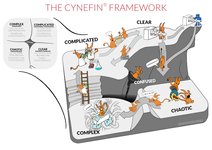systems and complexity
Cynefin® - um pouco sobre minha jornada e um convite
linkedin.com
arrangements where more people lead and follow, trust and reciprocity are fundamental values and thriving is linked to connection.
Curtis Ogden • Principles for Network Thinking and Action
network effects and change stem from many different experiments rather than looking for the single best answer.
Curtis Ogden • Principles for Network Thinking and Action
To keep you focused on the big picture, Peter Senge and Otto Scharmer describe problems as embodying three types of complexity:
- Dynamic Complexity. Where cause and effect are distant in time and space. When it is high, you need to take a systems approach that deals with all the interdependencies. When it is low, you can do a piece by piece
Jeff Mohr • What is complexity?




